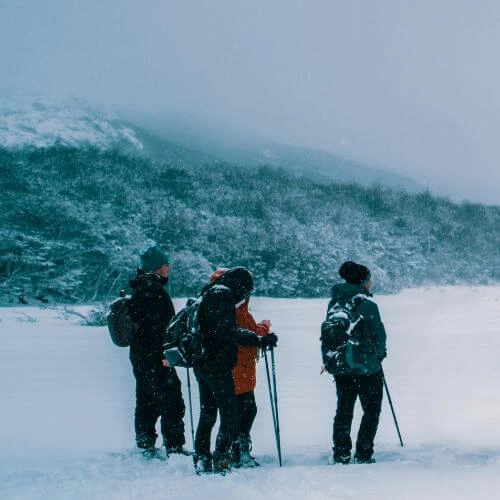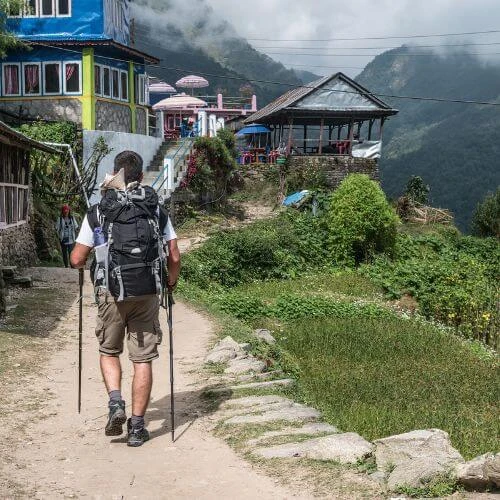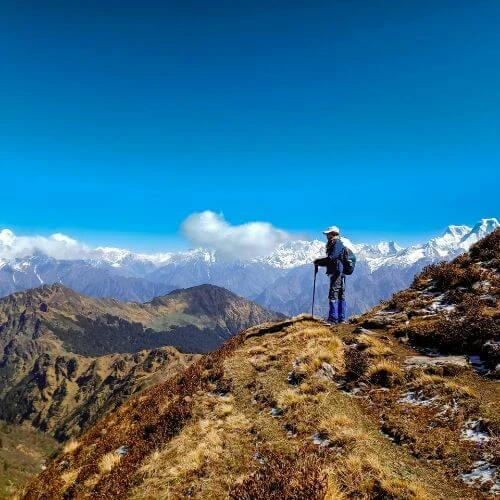RARA LAKE
Wedged in the Jumla and Mugu districts of Karnali province, the northwestern part of Nepal, Rara is the deepest lake at an altitude of 2,990 meters (9,810 ft) above sea level covering an area of 9.8 km2. Located at a high altitude, the main attraction is the snow trout found only in the waters of Rara and the lake changes its hue because of the changing weather. It is surrounded by the dense conifer forest of the famous Rara National Park; it is the center of the reserve.
There are many undemanding approaches to travel to Rara Lake as it is 864 km away from the capital, Kathmandu. One can travel via flight (Kathmandu to Nepalgunj and Nepalgunj to Mugu and walk around 3-4 hours to Rara Lake), bus, or take a ride on a bike. September/October and April/May is the best time to visit Rara.

GOKYO LAKE
In a world full of chaos, nothing is more serene than nature. So Gokyo can be your next stop to escape from your sedulous life. Occupying the 485 acres of land in Khumjung Village Development Committee of Solukhumbu District, it is the world’s highest freshwater lake system located at an altitude of 4,700 to 5,000m above sea level. The lake lies on the western side of the world-famous Mt. Everest where travelers can witness awe-inspiring views of the mountain. Also, the Gokyo Lake trip is the best alternate route to reach the Everest base camp and is less crowded compared to some other routes. The Gokyo Lake system embraces five lakes named Gokyo Cho(Dudh Pokhari, 3rd and the main lake with an area of 42.9ha), Thonak Cho(largest among the 5 lakes, 65.07ha), Gyazumpa Cho(28ha), Tanjung Cho(16.95ha), Ngozumpa Cho(14.39ha). The longest glacier (Ngozumpa glacier, below the sixth highest mountain in the world) can be seen in transit of the Gokyo Lake.
One can take a flight from Kathmandu to Lukla(30 mins) or take a bus to Jiri (7-8 hours). It will take you around 7 days to reach Gokyo Lake.

TILICHO LAKE
The finest trek destination in the Manang District, Tilicho Lake is famous for its beautiful waterfalls, lush greenery, and breathtaking mountains showcasing Thorong La Pass and astounding Jomsom. At an altitude of 4949 m above sea level, Tillicho Lake is situated in the Annapurna range of Nepal. The lake carries a religious significance as Hindus believe the lake is the ancient Kak Bhusundi lake mentioned in the epic Ramayana. The origin point of the lake is located in the city of Pokhara which stretches 55 kilometers. In 2000, a group of Russian divers conducted a dive in Tilicho Lakes stating it to be the site of one of the highest-ever altitudes of scuba dives.
Travelers can take a trip to Manang from Kathmandu crossing a place named Pisang, and then trek to ShreeKharka(5 hours) evidencing the rich culture and warm hospitality of the local villagers, then reach the Tilicho Lake.

GOSAIKUNDA LAKE
Gosaikunda Lake (13.8ha) is an alpine freshwater lake located in the Langtang National Park of Rasuwa District at an elevation of 4380m(14,370ft) above sea level which comprises about 10,30ha (2,500 acres) of total land surface including all the associated lakes. It was also designated as a Ramsar site, Wetlands of International Importance on the 29th of September,2007. There are about 108 lakes in the locale. The lake remains frozen for about six months from October to June then melts to form the Trisuli river.

Bearing some of the most prime religious values, Gosaikunda is an attraction for thousands of pilgrims following the Hindu religion in Nepal and India during a fair few occasions like Janai Purnima and Gangadashara. The theological stories like Bhagavata Purana, Vishnu Purana, and epics such as Ramayana and Mahabharata precisely refer to Samundra Manthan which is directly associated with the origin of the holy Gosaikunda Lake.
Intending to reach Gosaikunda, one needs to take a drive from Kathmandu to the trailhead of Gosainkunda, Dhunche(102km)with an estimated time of 5-7 hours via bus and stay a night there to continue approaching this astounding station the following day.
Abound Holidays can deliver you a fast and congenial helicopter ride of 17 minutes to get to Gosaikunda while exploring amazing views of the mountains and forest-clear skies.
BISH HAZARI LAKE
Installed in the inner terai of central Nepal, also known as the buffer zone of Chitwan National Park, Bishhazari Lake covers approximately 3,200ha(7,900 acres)of the total area of the southern corner of Bharatpur. The lake is at an altitude of 286m (938ft) above sea level. Bishhazari Lake is an extensive oxbow lake system encompassed by the Mahabharat Range(lower Himalayan range) to the North and the Siwalik Range to the South. This lake was designated as one of the Ramsar sites in August 2003.
The surroundings of Bishhazari Lake are the home to hundreds of mammals, birds, and reptiles including the Bengal tiger, sloth bear, smooth-coated otter,one-horned rhino, wild boar, and Indian porcupine, Indian peafowl, white-rumped vulture, Pallas fish eagle, lesser adjutant ferruginous duck, and other various creatures.
Bharatpur is only 25 mins away from the capital via flight while traveling by bus will take you 6 -7 hours. Travelers can hire a jeep safari from their respective hotels to the national park to relish the offerings of this setting. Bishhazari Lake is a gripping destination for reptiles and bird lovers.

PHEWA TAL/LAKE
A semi-natural freshwater lake formerly known as Baidam Tal, Phewa Lake (2434ft) is the biggest lake of Pokhara located in the southern part of the valley. According to the archives, Phewa Lake originated after constructing a dam during the Rana Regime. The prime attraction of Phewa Lake is the temple, Tal Barahi, on the island of the lake amid some breathtaking mountain peaks like Mount. Machhapuchhre, Annapurna, and Dhaulagiri in junction with Raniban or Queen’s Wood.
During the trip to Pokhara, a quick walk or ride to Phewa Lake will allow you to savor the tranquilizing experience of boating around the reservoir. Visitors can rent a boat with or without a sailor to sail around the lake. Due to the character of the lake, swimming is not safe in Phewa Lake.

PANCH POKHARI
Panchpokhari is posted at an altitude of 4100m above sea level being the base of Jugal Himal which includes Dorje Lhakpa(6966m), Madiya(6257m), Phurbi Chhyachhu(6637m). It is a famous consecrated pilgrimage site for Hindus and Buddhists during the month of July-August (Bhadra-Ekadashi to Janaipurnima) where the Hindu pilgrims take a dip in the holy water on the full moon day.
The most important attribute of Pachpokhari is the Langtang National Park located in Nuwakot, Rasuwa, taking over a chunk of the central Himalayan region. Even though it incorporates several high-altitude wetlands, it is not designated as a Ramsar site. It is a secluded and unwonted region even though it is within the reach of the capital.
With the cooperation of many travel companies or online services, trekkers can make it to Bhotang via bus( 10 hours) which comprehends 5 hours of smooth and 5 hours of a bumpy ride with 2 hours of walking to Panch Pokhari. Helitours is a lavish yet convenient channel to this wonder of nature.

GHODAGHODI LAKE
This large and shallow oxbow lake is a freshwater lake situated in the far-western development region of Nepal, Kailali, and occupies a total surface area of 2563ha (6,330 acres). At an altitude of 205m (673ft)above sea level on the lower slope of Siwalik region, its average depth is 4m (13 ft). Ghodaghodi Lake, encompassing 14 lakes and ponds, was allotted as a Ramsar site in August 2003 by UNESCO. The realm of Ghodaghodi is fenced by tropical deciduous forests and some rills that host a green corridor between the Terai lowland and Siwalik hills. Shelter for 26 mugger crocodiles(census of February 2021), aquatic macrophytes, several critically endangered mammals, and reptiles this lake complex is considered an IBA (Important Bird Area). Ghodaghodi Lake holds a religious value to the indigenous Tharu community which celebrates agan Panchami in December in a dedicated shrine for the Ghodaghodi deity.
You can easily approach this magnificent location via flight(1hrs 15mins) or by bus (12 hours) and sauce yourself up in the rich and abundant culture of the Tharu locals along with some mind-boggling delicacies.

SHEY-PHOKSUNDO LAKE
An alpine freshwater oligotrophic lake at an elevation of 3,611 m (11,849ft) with an average size of 494ha, Shey Phoksundo Lake is located within the territory of Shey Phoksundo National Park in the Dolpo district of Nepal. One of Nepal's largest and most beautiful lakes, the Phoksunda has become travelers' preferred location for trekking in Nepal. It is a Y-shaped lake encircled by 20 sacred Buddhist stupas in the southern belt and a gompa on the eastern side of the lake conducting yearly prayers and chants that take you to a completely different world showcasing the spirituality of Buddhism and Bon Po culture (religious tradition of Tibet).
A 50-minute non-stop flight or a 7-8-hour drive from Kathmandu to Nepalgunj will be your first step toward Shey Phoksundo. The second stop is a place named Jufal which takes 40 mins via flight from nepalgunj before approaching your final destination. With a continuous trail of boarding and alighting, you will be content with the vision of God's greatest gift to nature.

Birendra Tal
Another popular and fascinating turquoise lake in the foothills of the Manaslu Himal. A freshwater lake originating from the glacier of the Manaslu is the best part of the Manaslu Circuit Trek. It can be reached by 1hr hike from the beautiful Samagaon. Samagaon is the first acclimatization place during the Manaslu Circuit trekking that is located at an elevation of 3,690 m from the sea level.
Birendra Tal is named after the late King Birendra of Nepal. The lake is popular for those who like to take a bath in the icy water and experience the chilled vibes of the mountain. The lake was also explored on the way to Samdo village as it took only an hour to reach from Samagaon. Nepal’s beauty lies in nature and its people. In conjunction with countless lakes such as Mai Pokhari, Shey-Phoksundo Lake, Birendra Lake, Taudaha Lake, etc., there is much more in Nepal to experience and witness. From lushful green Terai, and hair-raising highlands to beautiful Himalayas, Nepal puts forward one of the most beautiful freshwater reservoirs dispensing a unique multiplicity in nature as well as culture. When exploring the lakes in Nepal, you will get a chance to uncover Nepal's illustrious culture, tradition, religion, history, food, and biodiversity.












.webp)


